

|

Lincoln Theatre - 2/7 Wurlitzer (original installation)
Mt. Vernon, Washington
712 S 1st St
Organ installation timeframe: 1926-present
Driving directions
Back to the Northwest Public Theatre Organ Installations page
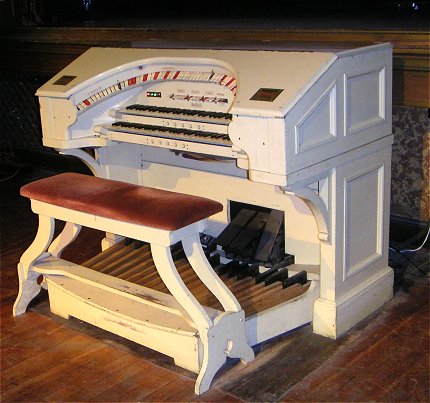
Lincoln Theatre console. Photo courtesy Dan Warner 2005
The Lincoln Theatre opened in April, 1926. Dubois Cornish was opening organist. James D. Barnard played in 1927. Mildred Elfstrom was also an early organist at the Lincoln.
The Lincoln Wurlitzer was Opus 1263, a Style D "Special." The addition of a Kinura, Marimba and Piano gave it the "Special" designation.
A unique feature of the Lincoln Wurlitzer are the exposed cathedral chimes (that also light up!) mounted on the auditorium columns. --->
Although the theatre has two chambers, the instrument was originally installed in the right chamber only.
The instrument has 4 percussions, 20 traps, a marimba harp and piano. |
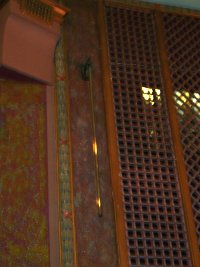 |

Lincoln Theatre entrance, 2005
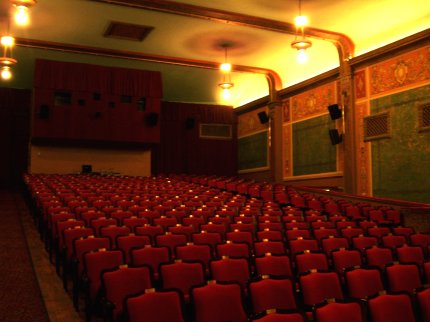
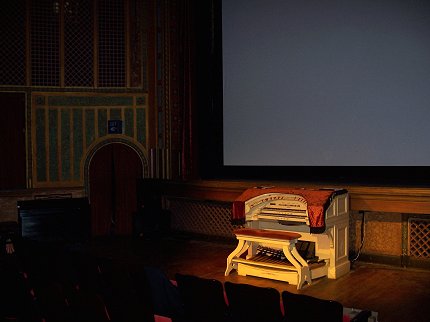
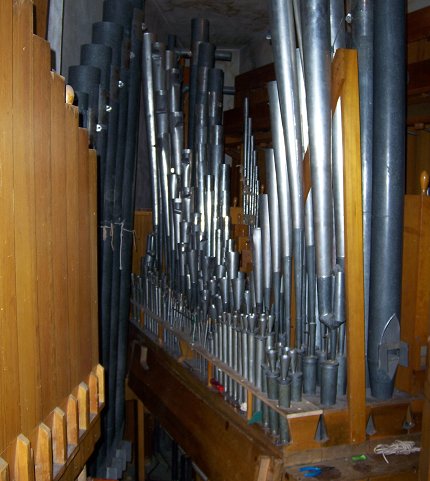
Pipe chamber, showing 7-rank windchest with "Special" Kinura to the left
A most unusual feature of the Lincoln Theatre Wurlitzer was the 73 note Kinura playable at 8 and 4 foot pitches on both manuals. This is very unusual for a Wurlitzer Kinura. The original switchstack spreader markings are shown below.

Kinura switchstack |

5HP blower |
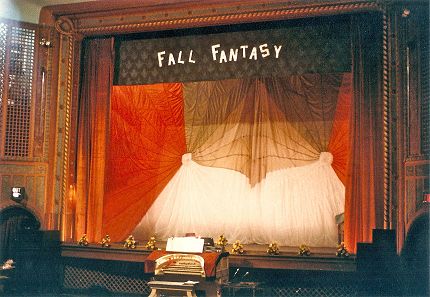
Stage set up for the Miss Skagit County Scholarship Pagent in 1984. The organ was played throughout the program. Photo courtesy Jeff Fox.

Photo courtesy Jim Stettner, 2006
In 1966, Brian Ingoldsby discovered the dormant instrument and spent almost four months full-time repairing various parts to get most everything working again. He presented a concert on June 4th, 1967 to interested PSTOS members and their friends.
|
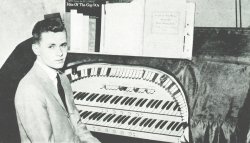
Brian Ingoldsby at the Lincoln, c.1967 |

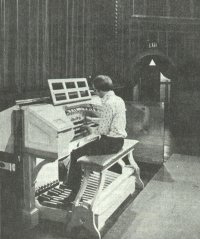
Don Abshier at the Lincoln, c. 1980 |
In the late 1970's, Jeff Fox, Ed Pollock and others spearheaded an effort to restore the instrument. The top two octaves of the Tibia and Flute were missing and someone had taken the added Kinura rank. These parts were replaced with money raised from benefit concerts performed by Jeff Fox. Other work included moving the percussions to the left chamber and returning the console to its original condition.
According to Jeff Fox, the original Kinura had 73 notes and was playable at 8 and 4 on both manuals. This is very unusual for a Wurlitzer Kinura. When the rank was removed years ago by an unknown party, they left the upper-12 in the chamber. |
As replacement, Jeff and Ed Pollock purchased a Welte Kinura in 1979. The original Wurlitzer rack board was removed and stored in the chamber and a new rack board was built for the Welte set.
The crew had the organ ready for the 1981 ATOS National Convention in Seattle. Unfortunately, the instrument was not featured at the convention due to scheduling and transportation difficulties.
According to John Pollock in a December 3, 2003 e-mail: "Ed Pollock, who was managing the building which included the Lincoln Theatre, died suddenly in 1985 at age 36. The theatre itself had been operated in recent years by various tenants, and was not infrequently on the brink of closure. The theatre and the surrounding shops were owned, and sold a few years later, by Elden, Robert and David Pollock. They were the grandsons of David F Decatur, on whose original homesite the theatre and surrounding shops had been built in 1926."
In 1990, the theatre got a new lease on life as a performing arts center. See the "Pages From The Past" section below for more information.
Be sure to visit the Lincoln Theatre's web site:

Lincoln Theatre, c.1926

S. 1st Street, Lincoln Theatre on right, c.1920's
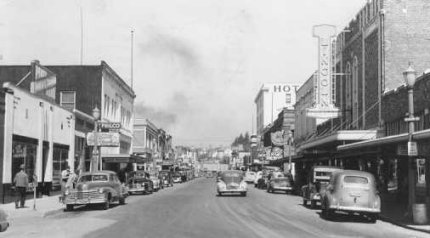
c.1940's

mid-1940's

Lincoln Theatre, c.2000
On April 8th 2001, Northwest organist Andy Crow helped to celebrate the theatre's 75th anniversary with his accompaniment of the 1927 Academy Award winner for Best Film: "Wings."
According to Peter Heffelfinger, former Theatre Director, work on the Wurlitzer during the 2000-2001 timeframe included a new power supply, re-leathered regulator, and work on the Marimba, Glockenspiel, and Chrysoglott.

|
A New Life for the Lincoln
Excerpt from a local daily, circa 1990:
Historic 1926 movie palace turned into arts showcase
Hundreds of people used to line up along South 1st Street in front of the glittering movie palace in
downtown Mount Vernon.
That was when movie admission was 35 cents, costumed usherettes led latecomers to their seats and children snuck in through the side door.
But in the 1990's, most movies are watched in unadorned cracker-box screening rooms or on the television screen. The luxury of the ornate theatres of the past has been all but forgotten.
In Mount Vernon, movie-lovers now can relive the glorious entertainment days gone by at the historic
Lincoln Theatre Center, thanks to an ever-growing group of dedicated volunteers and the support of the
downtown business community.
"It's still a 1926 movie theatre," said Ken Morgan, president of the Lincoln Theatre Center Foundation
Board of Directors. Although the lobby has been remodeled and new seats were installed in the 1940's,
the theatre remains much the same as it appeared on opening night, April 21, 1926, Morgan said.
That's unusual nowadays, when many such old theatres are being remodeled into six-plex movie houses or
town down to make way for new development.
The Lincoln was the creation of Edwin A. Halberg, and was designed by noted architect William Aitken
in the popular "period" motif of the Roaring Twneties. While Egyptian and Chinese designs appeared in
Seattle and other cities, Aitken selected a Spanish flavor for the Lincoln in Mount Vernon.
The facade features checkerboard sandstone designs, Moorish arched windows, cobblestone entryway and
a marquee that uses hand-cut masonite letters painted mahogany.
Inside, the walls are hand stenciled in bright-colored lattice-work designs. The original artwork was
preserved by black draperies that covered them up for years. The original main curtain of rich orange
velvet remains intact although a bit grimy from 70+ years of dust.
In the front of the stage is the centerpiece of the theatre the "mighty Wurlitzer" organ, which is one of just a few left in the country with its original installation. An advertisement from 1926 boasted that the Wurlitzer "all but talks," imitating sounds such as fire sirens, sleigh bells, rain and wind, Spanish castinets and car horns, with drums, bells, xylophone, marimba and chimes.
Halberg paid $22,500 for the organ, not including weeks of installation, and the building, owned by
W.E. Pollock, cost about $100,000. The adjoining buildings on 1st and Kincaid Streets costs about
$25,000.
About a year after the theatre opened, the silent firm era gave way to the "talkies." Many
classic films opened at the Lincoln during the years, including Al Jolson's "The Jazz
Singer" and most popular of all, the Shirley Temple movies.
During the 1930's, the theatre was one stop on the West Coast vaudeville circuit. Traveling
stage shows often stopped over in Mount Vernon enroute from Seattle to Vancouver, B.C.
Morgan said.
Many of those performers signed their names and write other comments on the plain wooden
door to the tiny backstage dressing room. The souvenir door eventually will become part of
an historical exhibit about the theatre, Morgan said.
He's done videotaped interviews with a number of long-time local residents who remember the
hey-day of the Lincoln, including three of the original six usherettes who opened the
theatre 64 years ago.
"They'd walk into the theatre, and there's this deja vu about what they remember," Morgan said.
Even the original teardrop chandeliers have been restored and reinstalled, after they were
discovered recently languishing in a junkyard.
The theatre was closed to the public and to movie screenings in 1984. The Pickett family
bought the building in 1985, but its future was unclear until a number of people interested
in the preservation of restoration of the theatre met in October 1986.
The Lincoln Theatre Center Foundation was formed with its mission to preserve, improve,
maintain and develop the theatre as a center for the performing arts. A seven-member board
and a crew of professional advisors, who donate their legan and accounting services, operate
the foundation, a nonprofit, tax-exempt organization.
"We have this terrific core of volunteers" who usher, vacuum, clean ann even sell popcorn
at public events, Morgan said. "And we've got state grants already."
One grant paid for the feasibility study for some modernization of the theatre, including
a lighting system for the stage and a sound system. Enlargement of the projection booth
would provide more space for controls and do away with the only access by ladder. In the
future, another exit may be needed, since construction of adjacent buildings blocked off
one the original exits.
A new grant will pay for a part-time manager to open the theatre for events and "to act
as a liaison between the community and the board," Morgan said. Applications are being
considered, and the coordinator will be hired this spring. he said.
In 1987, the theatre reopened to the public, after many hours of volunteer cleaning and
repairs, for an open house during the annual Skagit Valley Tulip Festival. The next
February, the foundation put on its first gala affair, a costumed fund-raiser featuring
music, dancing and a night of entertainment. The Third Annual Gala is planned for late
April or early May this year.
The theatre also brought touring theatrical productions and concerts to its stage, including
the Vela Luka Croation Dancers, a body-building championship, a country music festival, the
Bathhouse Theatre of Seattle, the Skagit Community Art Theatre of Sedro-Woolley, the Seattle
Peace Chorus, the Skagit Community Band and the Skagit Valley Symphony.
A new event introduced last year was a two-weekend film festival, featuring award-winning
foreign films that otherwise wouldn't have been available locally. The third festival
this February was "Just for Lovers," a revival festival featuring the classic "It Happened
One Night" with Clark Gable and Claudette Colbert, and "Picnic" with William Holden
and Kim Novak.
Film festivals are on opportunity to raise money for the operation of the theatre, and
it "opens the theatre for people who don't get to other events," Morgan said.
This spring, the Lincoln will be the site of the downtown merchants' Spring Fashion Show
on March 22 and the Little Miss Tulip Pageant on March 24. Films and tours will be
featured during the two-week Tulip Festival.
The theatre's biggest event yet is in the works for July 6, when the Lincoln helps
Mount Vernon celebrate the 100th anniversary of cityhood. Although many details have yet
to tbe confirmed, Morgan is writing and directing a recreation of the Theatre's opening
night.
The event will feature actors in 1920's costume, vintage vehicles from the Skagit Old Car
Club, a live stage show and a classic film. Morgan said he searched for the silent feature
that opened the theatre in 1926, but could find no trace of "Bluebeard's 7 Wives," so
another film of the era will be substituted.
Volunteers also plan to rebuild the free-standing ticket booth that once sat in front of
the theatre at the sidewalk. The centennial events all will be free, however. "There's
going to be a lot of stuff happening before the event even gets started," Morgan said.
More information about the theatre and the foundation is available by calling 336-2858. The
mailing address is P.O. Box 2312, Mount Vernon, Wash., 98273.
|
|
|





















